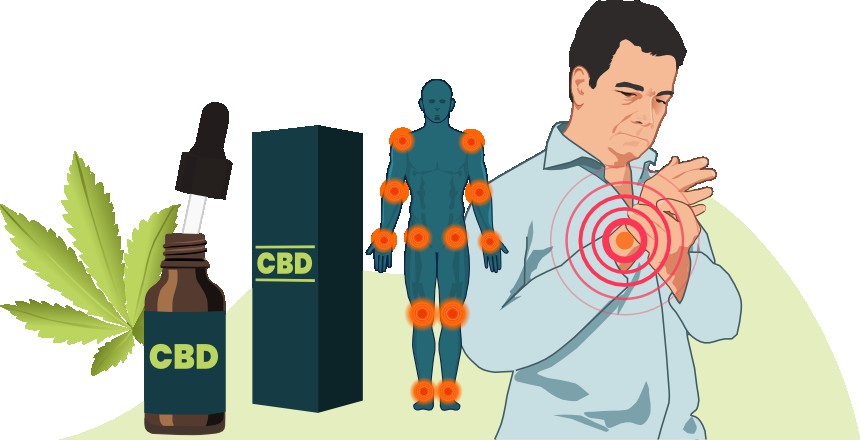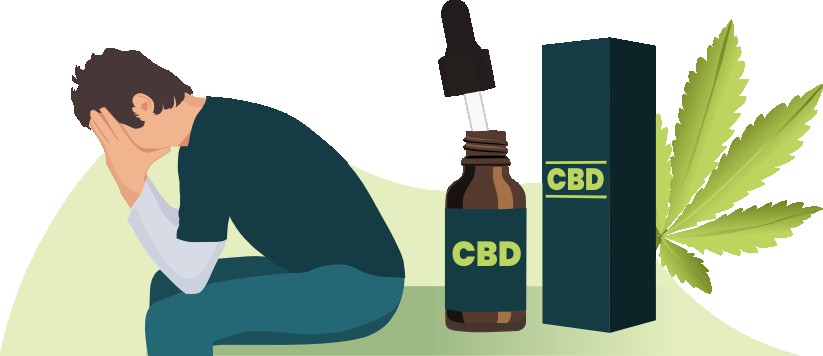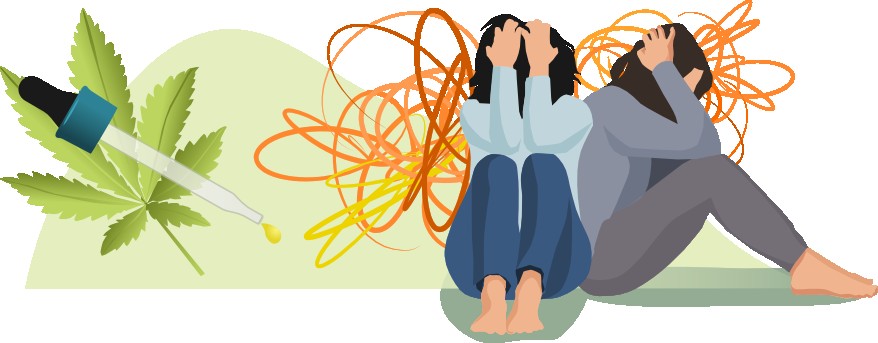Over the past decades, science has shown that CBD can be a beneficial compound for your health and well-being.
What most people interested in CBD don’t know, however, is that the cannabis plant species contains countless other beneficial compounds other than CBD.
One other type of beneficial compound found in cannabis plants is terpenes.
Many terpenes are associated with health benefits …
But studies indicate that they might also have a synergistic effect on CBD, potentiating its effects.
Today you’ll learn the connection between CBD and terpenes.
You’ll learn why it’s highly beneficial to have high concentrations of terpenes inside your CBD product.
Quick note: If you’re looking for a CBD oil that’s proven to be packed with beneficial cannabinoids, terpenes, and 100% free of contaminants, check out our list of best CBD oils.
CBD and Terpenes: Differences and Similarities
Terpenes and CBD are two different types of compounds. Both can be found in the cannabis plant species, but biochemically they’re different compounds.
Sometimes they have similar effects but work through acting on different receptor systems.
Let’s take a closer look.
What Are CBD and other Cannabinoids and What do They Do

The cannabis plant has one specific characteristic that makes it different than any other plant.
That characteristic is the following:
Cannabis plants contain cannabinoids. CBD stands for cannabidiol and is a cannabinoid. Cannabinoids are one of the few compounds that can directly interact with the human endocannabinoid system.
The human endocannabinoid system is a term that specifies the biological system that consists of:
- ‘Cannabinoid’ receptors,
- Their ligands called ‘endocannabinoids’, and;
- Enzymes.
The endocannabinoid system is associated with vital biochemical functions like:
- The functioning of the central nervous system (1);
- The functioning of neuronal activity (2);
- The functioning of the cardiovascular system (3).
By acting on the endocannabinoid system, cannabinoids can interact with physiological processes related to the central nervous system for example.
In fact, different studies have found countless benefits associated with cannabinoids.
The most common cannabinoids found in cannabis plants with their beneficial properties are:
| Painkilling | Anti-inflammatory | Anti-anxiety | Anti-depressant | Anti-oxidant | Anti-bacterial | Anti-tumor | Anti-epileptic | Anti-nausea | |
|---|---|---|---|---|---|---|---|---|---|
| CBD | | | | | | | | | |
| THC | | | | | | | | | |
| CBG | | | | | | | | | |
| CBC | | | | | | | | | |
| CBN | | | | | | | | | |
Source: Medicinal Properties of Cannabinoids, Terpenes, and Flavonoids in Cannabis, and Benefits in Migraine, Headache, and Pain: An Update on Current Evidence and Cannabis Science (4).
Only one of these cannabinoids is psychoactive: THC. THC is responsible for the buzz you feel when you smoke marijuana.
That said, the focus on cannabinoids when talking about cannabis-based products, has completely overshadowed another type of cannabis-derived compound: terpenes.
Different studies found that terpenes are associated with health benefits as well.
What Are Terpenes and What do They Do
Cannabis contains up to 200 different terpenes. Terpenes are fragrant essential oils secreted by all types of plants and herbs. They are the source of different aromas, flavors, and other characteristics that help differentiate between cannabis strains.
Terpenes aren’t psychoactive and can’t get you ‘high’.
Many health benefits associated with the terpenes overlap with those of cannabinoids.
The most common primary terpenes found in cannabis and its derived products (with their potential beneficial properties are):
| Painkilling | Anti-inflammatory | Anti-anxiety | Anti-depressant | Anti-oxidant | Anti-bacterial | Anti-tumor | Sleep-aid | Gastric-cytoprotective | |
|---|---|---|---|---|---|---|---|---|---|
| β-caryophyllene | | | | | | | | | |
| myrcene | | | | | | | | | |
| linalool | | | | | | | | | |
| limonene | | | | | | | | | |
| α-pinene | | | | | | | | | |
| humulene | | | | | | | | | |
| terpinolene | | | | | | | | | |
Source: Medicinal Properties of Cannabinoids, Terpenes, and Flavonoids in Cannabis, and Benefits in Migraine, Headache, and Pain: An Update on Current Evidence and Cannabis Science (4).
As you can see a lot of terpenes and cannabinoids have the same beneficial properties. But their beneficial properties are often expressed through different biochemical mechanisms.
Some researchers have noted that there’s a strong theoretical basis for the idea that terpenes enhance the beneficial effects of cannabinoids like CBD (5).
In one recent study done on epilepsy patients, researchers found that CBD-rich cannabis extract containing terpenes was 4-times more effective in reducing epilepsy, compared to purified CBD products without any terpenes or other cannabinoids than CBD (6). This is one of the reasons why at Herbonaut we always recommend getting a true full-spectrum CBD product. If you want to find one, check out our comparison article where we reviewed the best CBD oils.
Whether these differences in effect between CBD-rich cannabis extracts vs purified CBD can be attributed to terpenes isn’t clear yet. But as explained before there’s a strong theoretical basis to think it might.
What we do know for sure is the following:
Terpenes work both individually and synergistically with cannabinoids producing a variety of effects.
The Potential Beneficial Effects of CBD in Synergy with Terpenes
Let’s take a look at some specific studies that found the same beneficial effects for CBD and terpenes but through different biochemical mechanisms.
CBD and Terpenes Can Help with Pain

Current research shows that CBD has a strong affinity for interacting with 4 receptors that are associated with experiencing feelings of pain:
- Delta-opioid receptors;
- 5-HT1A (hydroxytryptamine) serotonin receptors;
- Adenosine receptors, and;
- TRPV1 receptors (vanilloid receptors)
That said, all the studies that looked at the exact biochemical mechanisms at play for explaining CBD’s painkilling effects were done on animals.
There are however studies that looked at CBD’s effects on pain in human subjects.
One recent study done on humans found that CBD can have painkilling effects (7). This study was done on 7 kidney transplant patients. Using CBD oil, 6 out of 7 patients significantly reduced pain.
The same study showed that CBD’s painkilling effects are highly dose-dependent and the effective dose can differ widely per individual.
Although many terpenes have been associated with anti-inflammatory and painkilling effects…
One study found that beta-caryophyllene was especially effective in the treatment of long-lasting, debilitating pain states that are related to neuropathic pain (8).
The researchers found that beta-caryophyllene targets and activates the cannabinoid receptor 2 (CB2), which has been associated with a reduction in neuropathic pain in previous studies.
The caveat here is that the study was done on mice. Further research should point out whether beta-caryophyllene is also effective in reducing neuropathic pain in humans.
As you can see, CBD and terpenes seem to have painkilling effects through different biochemical mechanisms:
CBD targets delta-opioid, 5-HT1A (hydroxytryptamine) serotonin, adenosine, and TRPV1 (vanilloid) receptors.
Beta-caryophyllene targets cannabinoid receptor 2 (CB2).
CBD and Terpenes Can Help with Depression

Although human clinical studies that looked at the effects of CBD on depression aren’t public yet, animal studies have shown that CBD has anti-depressant effects.
For example, a 2014 review study that looked at the results of over 10 CBD-depression-related studies, found that CBD has antidepressant-like actions through a mechanism that activated 5-HT1A neuro-receptors (9).
The 5-HT1A-receptor is a subtype of the 5-HT receptor, also called the serotonin receptor AKA the ‘happiness receptor.’
By activating 5-HT1A neuro-receptors, the researchers hypothesize that CBD could increase the presence and activity of serotonin neurotransmitters in the brain. Serotonin neurotransmitter activity has been associated with strong anti-depressant effects (10).
Although further research is needed, this means there’s a strong theoretical basis for the potential anti-depressant effects of CBD.
One specific terpene particularly, D-Limonene, has also been associated with strong anti-depressant effects.
A study done in 1995 found that citrus fragrance, which is packed with the terpene D-Limonene had strong anti-depressant effects on 12 depressive subjects (11). D-limonene normalizes neuroendocrine hormone levels and immune function. Interestingly enough, the citrus fragrance was more effective than antidepressants in normalizing neuroendocrine hormone levels and immune function.
The best part?
Some strains of Hemp contain very high levels of Limonene. Extracting the compounds out of a high-limonene hemp plant could theoretically result in a strong anti-depressant CBD oil.
CBD and Terpenes Can Help with Anxiety

The same mechanism that’s thought to be attributed to CBD’s anti-depressant effects, could be responsible for its anti-anxiety effects as well.
Social anxiety disorder has been associated with reduced 5-HT1A-receptor binding (12). Researchers have noted that agents that target 5-HT1A-receptors could lead to anti-depressant effects (13). As you’ve read in the paragraph above, CBD is an agent that targets 5-HT1A-receptors.
In fact, multiple studies that looked at the effects of CBD on (social) anxiety have shown that CBD can indeed reduce anxiety.
For example, one study done in 2011 found that the administration of CBD to ‘social anxiety disorder’ patients, just before they underwent a public speaking test, significantly reduced anxiety levels and improved speech performance.
Terpenes as well, specifically limonene and linalool, have shown to have an anxiety-reducing effect. Anecdotal evidence for essential oils that contain limonene reducing anxiety is plenty, studies are a bit rarer. There are a few, however.
For example, one study done in 2013 showed that inhaled limonene reduced anxiety in mice that were subjected to an elevated plus-maze test (14).
Linalool as well has been shown to have anti-anxiety effects in multiple studies. For example, a 2011 study showed that inhaled linalool reduced anxiety in mice that were subjected to an elevated plus-maze test (15).
Both limonene and linalool can be found in high concentrations in some strains of hemp.
If you’re using CBD for anxiety relief, then you have a strong theoretical basis to look for products that contain both CBD and relatively high levels of limonene and linalool. They could enhance each other’s anti-anxiety effects.
CBD and Terpenes Can Help with Acne
It is thought that one root cause of acne is an increased production of ‘sebum’.
Sebum is an oily substance produced by glands just underneath your skin. This sebum plays a critical role in maintaining the health of your skin for example by forming a protective layer against harmful microbials.
Now, when your ‘sebaceous glands’ produce too much sebum, the result can be acne.
Studies have shown that high doses of CBD can lead to sebocyte apoptosis (death of sebum cells), which in turn could lead to a decrease in acne (16).
The terpenes limonene and linalool as well have been shown to have a positive effect on acne (17, 18). Both of these terpenes have anti-inflammatory effects specifically related to inflammation that’s associated with Propionibacterium acnes.
By combining both CBD and these terpenes, theoretically, you could have an effective anti-acne combination of compounds because both of these compounds would target different mechanisms that are associated with the occurrence of acne.
Conclusion
Today you’ve learned that there’s a strong theoretical basis for combining CBD with terpenes.
Both CBD and terpenes have been shown to have beneficial effects for conditions like anxiety, acne, and depression through sometimes different mechanisms.
This suggests that combining CBD with terpenes could be more effective than using CBD alone.
Both CBD and terpenes are associated with countless health benefits. Some researchers suggest that CBD works best in combination with other naturally occurring compounds found in the hemp plant, through a process they call ‘the entourage effect’.
Well, today you’ve learned terpenes might play an important role in this effect.
What’s Next…
If you want to dive deeper into the science of CBD, we have several articles which explain in layman’s terms, the potential benefits of CBD.
You can find these potential benefits (backed by scientific research), here:
If you’re looking for a CBD oil, it’s CRUCIAL that you get a CBD oil that’s 100% free of contaminants and contains a high concentration of CBD. Check the article below to find:
If you want to learn the best ways to use and dose CBD oil, check out our guide on:
If you’re interested in vaping CBD, check out our list of:
If you’re interested in a more convenient (but less potent) way to use CBD, check out our list of:
If you have pain issues and want to understand the biology and science behind using CBD oil for pain, the following article is for you:
If you have anxiety issues and want to understand the biology and science behind using CBD oil for anxiety, the following article is for you:
Lastly, if you want to share this CBD knowledge, click the links below OR if you want to connect with us, click the links below that to go to our Facebook or Instagram pages.
Scientific References:
-
Zou, S., & Kumar, U. (2018). Cannabinoid Receptors and the Endocannabinoid System: Signaling and Function in the Central Nervous System. International Journal of Molecular Sciences, 19(3), 833. https://doi.org/10.3390/ijms19030833
- Marsicano, G., & Lutz, B. (2006). Neuromodulatory functions of the endocannabinoid system. Journal of endocrinological investigation, 29(3 Suppl), 27–46. https://pubmed.ncbi.nlm.nih.gov/16751707/
-
Montecucco, F., & di Marzo, V. (2012). At the heart of the matter: the endocannabinoid system in cardiovascular function and dysfunction. Trends in Pharmacological Sciences, 33(6), 331–340. https://doi.org/10.1016/j.tips.2012.03.002
-
Baron, E. P. (2018). Medicinal Properties of Cannabinoids, Terpenes, and Flavonoids in Cannabis, and Benefits in Migraine, Headache, and Pain: An Update on Current Evidence and Cannabis Science. Headache: The Journal of Head and Face Pain, 58(7), 1139–1186. https://doi.org/10.1111/head.13345
-
Russo, E. B. (2011). Taming THC: potential cannabis synergy and phytocannabinoid-terpenoid entourage effects. British Journal of Pharmacology, 163(7), 1344–1364. https://doi.org/10.1111/j.1476-5381.2011.01238.x
-
Pamplona, F. A., da Silva, L. R., & Coan, A. C. (2018). Potential Clinical Benefits of CBD-Rich Cannabis Extracts Over Purified CBD in Treatment-Resistant Epilepsy: Observational Data Meta-analysis. Frontiers in Neurology, 9. Published. https://doi.org/10.3389/fneur.2018.00759
-
Cuñetti, L., Manzo, L., Peyraube, R., Arnaiz, J., Curi, L., & Orihuela, S. (2018). Chronic Pain Treatment With Cannabidiol in Kidney Transplant Patients in Uruguay. Transplantation Proceedings, 50(2), 461–464. https://doi.org/10.1016/j.transproceed.2017.12.042
-
Klauke, A. L., Racz, I., Pradier, B., Markert, A., Zimmer, A., Gertsch, J., & Zimmer, A. (2014). The cannabinoid CB2 receptor-selective phytocannabinoid beta-caryophyllene exerts analgesic effects in mouse models of inflammatory and neuropathic pain. European Neuropsychopharmacology, 24(4), 608–620. https://doi.org/10.1016/j.euroneuro.2013.10.008
-
Schier, A., Ribeiro, N., Coutinho, D., Machado, S., Arias-Carrion, O., Crippa, J., . . . Silva, A. (2014). Antidepressant-Like and Anxiolytic-Like Effects of Cannabidiol: A Chemical Compound of Cannabis sativa. CNS & Neurological Disorders – Drug Targets, 13(6), 953–960. https://doi.org/10.2174/1871527313666140612114838
-
Young S. N. (2007). How to increase serotonin in the human brain without drugs. Journal of psychiatry & neuroscience : JPN, 32(6), 394–399. https://www.ncbi.nlm.nih.gov/pmc/articles/PMC2077351/
-
Komori, T., Fujiwara, R., Tanida, M., Nomura, J., & Yokoyama, M. M. (1995). Effects of Citrus Fragrance on Immune Function and Depressive States. Neuroimmunomodulation, 2(3), 174–180. https://doi.org/10.1159/000096889
-
Lanzenberger, R. R., Mitterhauser, M., Spindelegger, C., Wadsak, W., Klein, N., Mien, L. K., . . . Tauscher, J. (2007). Reduced Serotonin-1A Receptor Binding in Social Anxiety Disorder. Biological Psychiatry, 61(9), 1081–1089. https://doi.org/10.1016/j.biopsych.2006.05.022
-
Albert, P. R., & Lemonde, S. (2004). 5-HT1A Receptors, Gene Repression, and Depression: Guilt by Association. The Neuroscientist, 10(6), 575–593. https://doi.org/10.1177/1073858404267382
-
Bergamaschi, M. M., Queiroz, R. H. C., Chagas, M. H. N., de Oliveira, D. C. G., de Martinis, B. S., Kapczinski, F., . . . Crippa, J. A. S. (2011). Cannabidiol Reduces the Anxiety Induced by Simulated Public Speaking in Treatment-Naïve Social Phobia Patients. Neuropsychopharmacology, 36(6), 1219–1226. https://doi.org/10.1038/npp.2011.6
-
Souto-Maior, F. N., Carvalho, F. L. D., Morais, L. C. S. L. D., Netto, S. M., de Sousa, D. P., & Almeida, R. N. D. (2011). Anxiolytic-like effects of inhaled linalool oxide in experimental mouse anxiety models. Pharmacology Biochemistry and Behavior, 100(2), 259–263. https://doi.org/10.1016/j.pbb.2011.08.029
-
Oláh, A., Tóth, B. I., Borbíró, I., Sugawara, K., Szöllõsi, A. G., Czifra, G., . . . Bíró, T. (2014). Cannabidiol exerts sebostatic and antiinflammatory effects on human sebocytes. Journal of Clinical Investigation, 124(9), 3713–3724. https://doi.org/10.1172/jci64628
-
KIM, S. S., BAIK, J. S., OH, T. H., YOON, W. J., LEE, N. H., & HYUN, C. G. (2008). Biological Activities of KoreanCitrus obovoidesandCitrus natsudaidaiEssential Oils against Acne-Inducing Bacteria. Bioscience, Biotechnology, and Biochemistry, 72(10), 2507–2513. https://doi.org/10.1271/bbb.70388
-
Raman, A., Weir, U., & Bloomfield, S. (1995). Antimicrobial effects of tea-tree oil and its major components on Staphylococcus aureus, Staph. epidermidis and Propionibacterium acnes. Letters in Applied Microbiology, 21(4), 242–245. https://doi.org/10.1111/j.1472-765x.1995.tb01051.x